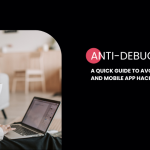Continuous Integration and Continuous Delivery (CI/CD) are becoming the standard for how software is built and deployed. As a result, developers are responsible for more security in the application development life cycle than ever before.
Continuous integration (CI) frequently integrates shared mainlines with all developer working copies. Whereas Continuous delivery (CD) goes one step further. Your application can be instantly deployed to production after passing a set of tests in the staging environment with just a few clicks from any team member.
In this article, let’s explore CI/CD security and understand the common security threats you must watch to keep your builds secure.
Ready to protect your app?
Start 30-days FREE TRIAL. No credit card required. Deliver Secure Mobile Apps Faster in minutes with the leader in application security.

CI/CD Security
CI/CD, or Continuous Integration/Continuous Delivery, is a practice in which development teams automatically build and deploy code changes to a production environment. This practice enables development teams to deliver new features and updates faster while reducing the risk of human error.
It is important to consider the following factors to ensure the CI/CD security of pipelines:
Source code management: All code changes should be tracked and stored in a secure source code management system like Git. This will enable development teams to roll back changes if necessary and provide an audit trail in a security incident.
Build server security; The build server should be configured with appropriate security controls, such as firewalls and access control lists. Build servers should also be updated with the latest security patches.
Deployment target security: Care should ensure that the production environment is properly secured before the code is deployed. This includes ensuring that only authorized users have access to production servers and that proper authentication and authorization mechanisms are in place.
Runtime security: Once the code is deployed to production, it is important to monitor the runtime environment for potential security issues. This includes monitoring unauthorized access, SQL injection attacks, and cross-site scripting attacks.
By considering these factors, development teams can build secure CI/CD pipelines that will help them deliver new features and updates faster while reducing the risk of human error.
5 Common Security Threats in CI CD Security
Many potential security threats can occur during the CI/CD process. Below are some of the most common threats, along with an explanation of how they can happen:
Unauthorized Access
One of the most common security threats is unauthorized access. This can occur when developers do not properly restrict access to the build server or when deployment targets are not properly secured. Unauthorized access can lead to data breaches and other serious security incidents.
SQL Injection Attacks
SQL injection attacks can occur when untrusted input is included in SQL queries. This can happen if the built server does not properly sanitize user input or if developers do not use parameterized queries. SQL injection attacks can allow attackers to access sensitive data, such as passwords and credit card numbers.
Cross-Site Scripting Attacks
Cross-site scripting (XSS) attacks can occur when untrusted input is included on web pages without proper sanitation. This can happen if the build server does not properly sanitize user input or if developers do not escape special characters correctly. XSS attacks can allow attackers to inject malicious code into web pages, which can be executed by unsuspecting users who visit the page. This malicious code could redirect users to a malicious website, steal sensitive information, or even install malware on their computers.
Insufficient Flow Control Mechanisms
Another common security threat is insufficient flow control mechanisms. This can occur if the build server does not properly check for errors before continuing the build process. Inadequate flow control mechanisms can lead to data leaks and other security issues.
Dependency Chain Abuse
Dependency chain abuse can occur when development teams do not properly manage dependencies. This can happen if developers include outdated or vulnerable dependencies in their applications. Dependency chain abuse can lead to serious security issues, such as data breaches and denial of service attacks.
How to Properly Ensure Your CI/CD Pipeline Is Secured?
There are many ways to properly ensure your pipeline’s CI CD security. Let’s look at seven of the most common ways to do so.
Establish a Clear Security Policy for Your CI/CD Pipeline
Define what is considered sensitive data and how it should be handled, establish who has access to the pipeline and what level of access they have, specify which security scanning tools will be used and how often, etc.
Use Only Trusted Sources for Your Code and Dependencies
Download code and dependencies from reputable sources that you trust. Verify the authenticity of all downloads using cryptographic signatures whenever possible.
Scan All Code and Dependencies for Vulnerabilities Before Adding Them to the Pipeline
Use a security scanning tool (e.g., OWASP Dependency Check) to scan your code and dependencies for known vulnerabilities. Fix any vulnerabilities found before adding the code or reliance to the pipeline.
Use Secure Authentication and Authorization Methods for Accessing the CI/CD Pipeline
Configure your CI CD security software to use strong authentication methods (e.g., two-factor authentication) for all users who need access to the pipeline. Authorize each user’s access based on their role in the organization (e.g., developers should only have access to parts of the pipeline relevant to their work).
Encrypt All Data in Transit Through the Pipeline Using Tls/SSL Protocols
Configure your toolset to encrypt all data in transit between the various components of the pipeline (e.g., between the code repository and the build server). This will help protect sensitive data from being intercepted by malicious actors.
Protect Sensitive Data at Rest by Encrypting It or Storing It in a Secure Location
Store sensitive data used by the CI/CD pipeline (e.g., passwords, API keys) in an encrypted format or a secure location such as Hashicorp Vault. This will help prevent unauthorized access to this data if the CI/CD system is compromised.
Regularly Review Logs and Monitor Activity on the CI/CD Pipeline
Review logs generated by the CI/CD security system regularly to look for suspicious activity. Monitor activity on the pipeline closely to ensure that only authorized users are accessing it and only doing so for legitimate purposes.
Start Protecting Your Software With Proper CI CD Security
AppSec providers should work closely with their clients to ensure that their security programs are running as efficiently as possible. By collaborating with clients, AppSec providers can help them fine-tune their programs to better protect their data and resources.
Final Thoughts
While software becomes increasingly integral to businesses, the security of daily tools is becoming increasingly important. Be it static or dynamic analysis, and manual penetration testing, moving security testing earlier in the life cycle is one measure that can help reduce friction and improve release velocity.
Using appropriate tools, like AppSealing, at the right moment can also help decrease overall friction, boost release velocity, and enhance the quality and safety of released applications. CI/CD security can greatly benefit your overall application development and maintenance in the long term.
Ready to protect your app?
Start 30-days FREE TRIAL. No credit card required. Deliver Secure Mobile Apps Faster in minutes with the leader in application security.







